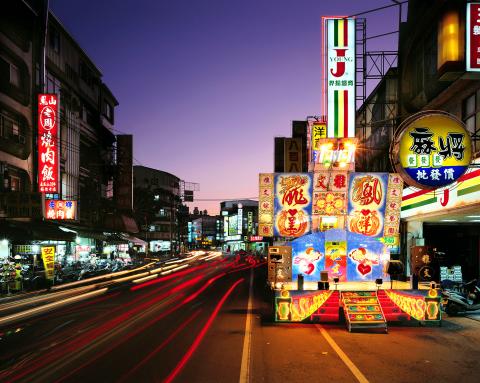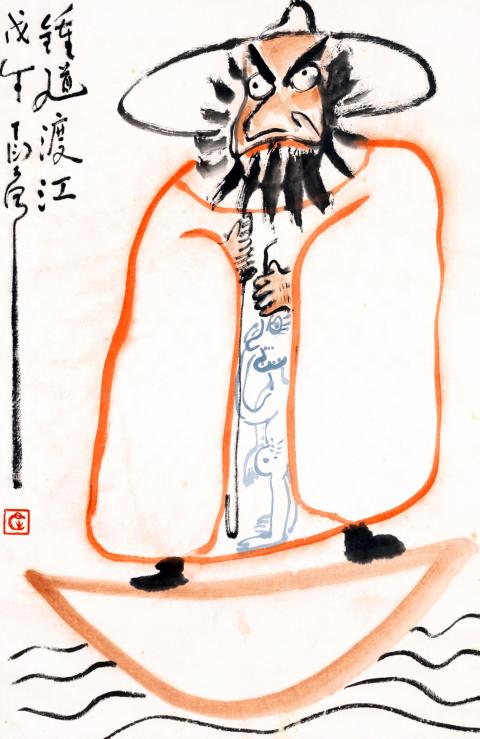Illusion Reality — The Photo Exhibition of Shen Chao-liang features work from the three-time Golden Tripod Award-winning photographer. Shen Chao-liang (沈昭良) latest set, Stage, captures the stage trucks used by Taiwan’s traveling song-and-dance troops, which at sunset are trance-inducing and electric. Another project, Singer & Stage, is portraits of the traveling performers, who are mostly young single women in their late 20s and early 30s. Liang (b. 1968) won the Golden Tripod Award for Best Photography in 2000, 2002 and 2012. He was awarded the New-York based Artists Wanted: Photography Category Award in 2011 and first place in the International Photography Award for the Book of Documentary last year.
■ The Pier-2 Art Center (高雄駁藝術二特區), 1 Dayong Rd, Greater Kaohsiung (高雄市大勇路1號), tel: (07) 521-4899. Open Mondays to Thursdays from 10am to 6pm, Friday and Saturdays from 10am to 8pm. Free admission
■ Opens today. Until Sept. 22

Photo Courtesy of Aki Gallery
Living as Form (生活作為形式) is a group exhibition curated by Nato Thompson, of the New York-based public arts institution Creative Time. Using film and color images, Thompson gives a tour of society-changing art projects by 22 international artists and civic organizations. Works include Fairytale: 1,001 Chinese Visitors (童話:一千零一位中國遊客) by Ai Weiwei (艾未未), which sees the artist turning an old German textile mill into a showpiece and free-of-charge hostel for economically disadvantaged Chinese visitors. On August 24, Thompson will open Part II of Living as Form, which spotlights local artists like Wang Hong-kai (王虹凱) and labor organization Black Hand Nakasi (黑手那卡西).
■ TheCube Project Space (立方計畫空間), 2F, 13, Alley 1, Ln 136, Roosevelt Rd Sec 4, Taipei City (台北市羅斯福路四段136巷1弄13號2樓), tel: (02) 2368-9418. Open Tuesdays through Sundays from 12pm to 7pm
■ Until August 11

Photo Courtesy of NPM
Shuanglian Sound Environment (雙連聲態) by Tsai Kuen-lin (蔡坤霖) is a new interactive installation at the Taipei Metro Shuanglian Station. It’s an intricate network of colored pipes resembling the metro’s routes. Put your ear next to one at scheduled intervals and you can hear the simulated sound of railway trains pulling in, like they used to at the long-gone Shuanglian Train Station. Created on commission, the interactive sculpture is part of the Museum of Contemporary Art, Taipei’s campaign to bring contemporary art to the MRT and its underground.
■ Metro Taipei, Shuanglian Station (Near Exit 2) 台北捷運雙連站 (2號出口旁)
■ Permanent display
Supernatural Tales of Gods and Ghosts: Paintings from the Museum Collection (神鬼傳奇) introduces visitors to demons, goblins and other paranormal figures of Chinese antiquity. Over 30 paintings, dating from the Jin dynasty (265 and 420 CE) to 1978, show popular ghosts like the Eight Immortals (八仙) and the Picking-Fungus Immortal (採芝仙), as well as the lesser-known Goddess of the Luo River (洛神). Also at the National Palace Museum, The Ancient Art of Writing: Selections from the History of Chinese Calligraphy (筆有千秋業) presents calligraphy works from the Qin dynasty (221-206 BC) to the Qing dynasty (1644-1911) in chronological order.
■ National Palace Museum (國立故宮博物院圖書文獻大樓), 221 Zhishan Rd Sec 2, Taipei City (台北市至善路二段221號), tel: (02) 2881-2021. Open daily from 9am to 5pm
■ Until Sept. 30
Six contemporary artists think that Imax 3D experience shouldn’t be so expensive. No Promising Video Art Fest (沒出息3D錄像影展) is their alternative: A recycled cardboard box fitted with a lens so that a viewer can enjoy their six original microfilms in real 3D. But while this theater is cheap, it seats only one, so the experience is lonely and even alienating.
■ Fotoaura (海馬迴光畫館), 4F, 83 Chenggong Rd, Tainan City (台南市成功路83號4樓), tel: (06)222-3495. Open Wednesdays to Sunday from 1pm to 8pm
■ Until July 27

Nov. 11 to Nov. 17 People may call Taipei a “living hell for pedestrians,” but back in the 1960s and 1970s, citizens were even discouraged from crossing major roads on foot. And there weren’t crosswalks or pedestrian signals at busy intersections. A 1978 editorial in the China Times (中國時報) reflected the government’s car-centric attitude: “Pedestrians too often risk their lives to compete with vehicles over road use instead of using an overpass. If they get hit by a car, who can they blame?” Taipei’s car traffic was growing exponentially during the 1960s, and along with it the frequency of accidents. The policy

What first caught my eye when I entered the 921 Earthquake Museum was a yellow band running at an angle across the floor toward a pile of exposed soil. This marks the line where, in the early morning hours of Sept. 21, 1999, a massive magnitude 7.3 earthquake raised the earth over two meters along one side of the Chelungpu Fault (車籠埔斷層). The museum’s first gallery, named after this fault, takes visitors on a journey along its length, from the spot right in front of them, where the uplift is visible in the exposed soil, all the way to the farthest

While Americans face the upcoming second Donald Trump presidency with bright optimism/existential dread in Taiwan there are also varying opinions on what the impact will be here. Regardless of what one thinks of Trump personally and his first administration, US-Taiwan relations blossomed. Relative to the previous Obama administration, arms sales rocketed from US$14 billion during Obama’s eight years to US$18 billion in four years under Trump. High-profile visits by administration officials, bipartisan Congressional delegations, more and higher-level government-to-government direct contacts were all increased under Trump, setting the stage and example for the Biden administration to follow. However, Trump administration secretary

The room glows vibrant pink, the floor flooded with hundreds of tiny pink marbles. As I approach the two chairs and a plush baroque sofa of matching fuchsia, what at first appears to be a scene of domestic bliss reveals itself to be anything but as gnarled metal nails and sharp spikes protrude from the cushions. An eerie cutout of a woman recoils into the armrest. This mixed-media installation captures generations of female anguish in Yun Suknam’s native South Korea, reflecting her observations and lived experience of the subjugated and serviceable housewife. The marbles are the mother’s sweat and tears,